This beautiful and vibrant saltwater fish is known as clown tang fish (clown Surgeonfish, Lined Surgeonfish, or Blue-banded Surgeonfish are other common names). You can easily rear this active fish in your aquarium with proper guidance. This article includes all essential knowledge regarding How to care for clown tang. Read this article carefully and keep this lovely fish in your reef tank.
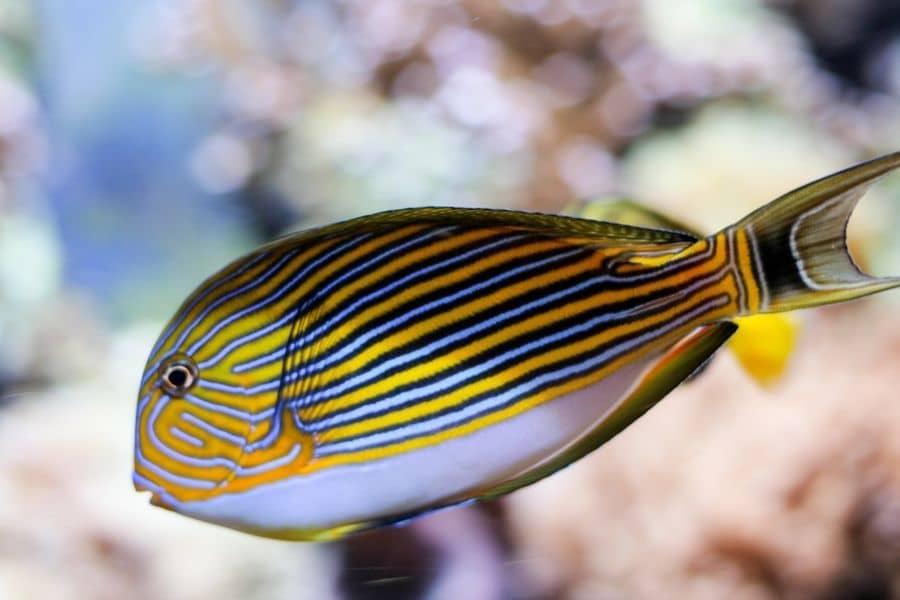
What are clown tangs?
Jump To
- 1 What are clown tangs?
- 2 Why are clown tangs so hard to keep?
- 3 One look Care Guide
- 4 The appearance of clown tangs
- 5 Tang colors and types
- 6 Tank requirements
- 7 Acclimatization to tank
- 8 How to breed clown tang
- 9 How fast do clown tang grow
- 10 What does clown tang eat?
- 11 Clown tangs tank mates
- 12 Predators of clown tang
- 13 Why is clown tang dying?
- 14 Parasite disease on clownfish/ clownfish disease
- 15 How much they cost
- 16 Related topics
Clown Tangs are an extremely energetic and vibrant fish and one of the sought species in saltwater aquariums. Their bodies are yellow. The light blue color horizontal stripes create a unique pattern on their body. There are black outlines just after the blue color strips. These blue color strips go along the dorsal fin too. There are black outlines on the dorsal and caudal fins. Their belly area is white or light blue.
Clown surgeonfish were found in Indo-Pacific regions of the world. They are commonly associated with coral reefs. Clown tang can live 25-30 years in the wild. They can reach up to 14 inches and prefer high oxygenated water. Thus, they inhabit an environment that has water currents. Clown tangs are relatively aggressive fish and they highly consider their territory boundaries. The ideal water conditions should be provided in captivity to enhance their life span.
The water temperature should be in between 72- 80 Fahrenheit, and the pH is 8.1-8.4. They require 1.023-1.025 specific gravity saline water and hardness should be in between 8-12 dkH.
The important factor is, that you can add them to saltwater aquariums and community tanks. They will live peacefully there. But do not add them with the same variety of clown tang fish. Because they are not good tank mates in captivity. But you can add other “Tang” fish that have different appearances? Clown tang. Then, they can live together peacefully.
Why are clown tangs so hard to keep?

Clown tangs need special parameters to live healthy and peacefully. They need high open space to swim. Thus you need to have a big tank (180 gallons minimum). Further, they need a high flow rate and you should install a powerhead or tide maker in the tank. In the beginning, they refuse food in captivity and you must pay attention to that. You can set some Nori food pellets under the rock and clown tangs will nip it gradually. You have to practice it until they are ready to eat other formulated foods.
Furthermore, clowns do not like to live with their cousins. Thus, you cannot add a pair of clown tangs into the same tank.
One look Care Guide
| Scientific name | Acanthurus lineatus |
| Common name | Clown Surgeonfish, Lined Surgeonfish, or Blue-banded Surgeonfish |
| Care level | Expert |
| Reef Compatible | Yes |
| Native to | Fiji, Maldives, New Caledonia (Indo- Pacific region) |
| Type | Fish |
| Color | Blue, Orange, Yellow |
| Tank size | Minimum 180 gallons |
| Preferred temperature | 72- 80° F |
| Water parameters | 8-12 dKH, pH 8.1-8.4 |
| Preferred salinity | 1.020-1.025 SG |
| Size | Maximum Size 14 inches |
| Growth rate | One inch for 6 months |
| Temperament | Semi-aggressive |
| Recommended tank mates | Purple tangTomini tangYellow tangScopas tangSailfin tang |
| Preferred food | Algae, diatoms |
| Feeding frequency | 3 times per day |
| breeding | Difficult in captivity |
The appearance of clown tangs

Generally, clown tangs have disk shapes and laterally flattened bodies. They have horizontal electric blue strips on their yellow or orange color body. There is a black color outline just after the blue color strips and dorsal and caudal fins. The lower part of their body is white. Their black eyes are highlighted on the head area. Clown tangs have “scalpel” like sharp peduncle spines running along each side of caudal fins. Clown tangs use these spines to protect from predators and protect their territory.
The anal and dorsal fins of clown tang fish are much larger. The dorsal fin also consists of yellow and blue color horizontal stripes. If fins are fully extended, clownfish’s total body length and height are relatively the same. Clownfish are associated with coral reefs and are abundant in the Indo-Pacific region. They generally live in the tropical waters of Fiji, the Philippines, Maldives, and New Caledonia.
Tang colors and types
Tangs are an extremely amazing reef fish variety and there are eight types in the Tang group. These eight varieties are dramatically different from other varieties. All tangs have unique color patents and body shapes. Moreover, their tank requirement varies for each variety.
Achilles Tang (Acanthurus Achilles)
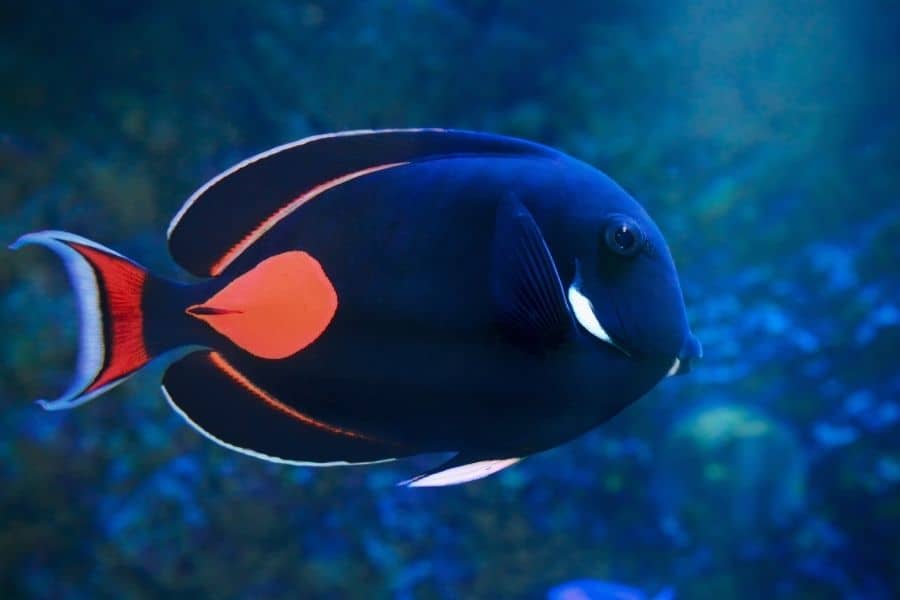
This amazing beauty’s body is covered with back scales and has an oval-shaped orange patch near the tail area. You can add Achilles tang to your reef tank to create unique beauty.
- Minimum tank requirement -120 gallons
- Length: 10 inches (25 cm)
- Minimum tank Size: 120 gallons (454 l)
- Salinity requirement: 1.023-1.025 specific gravity
- Care level: Expert
- Temperament: Aggressive
- Natural Habitat: Pacific region coral reef environment
- Cost: $400-$600
Black Tang (Zebrasoma rostratum)
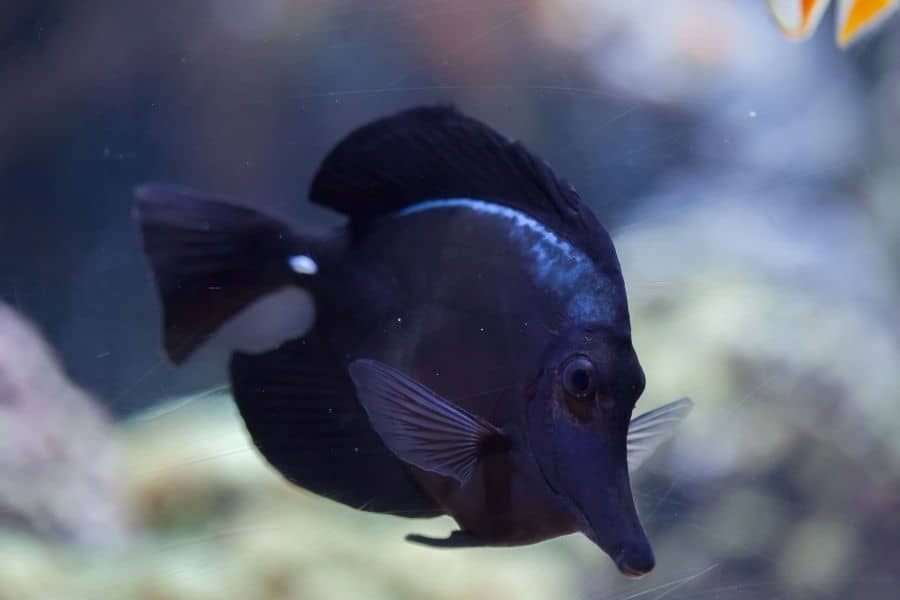
The whole body of the black tang is solid black in color and has a pointed mouth like a bird. They are a rare fish variety
- Minimum tank requirement -120 gallons
- Length: 10 inches (25 cm)
- Minimum tank Size: 120 gallons (454 l)
- Salinity requirement: 1.023-1.025 specific gravity
- Care level: Easy
- Temperament: Aggressive
- Natural Habitat -Pacific region, coral reef environment
- Cost: $600-$1400
Royal Blue Tang/Palette surgeonfish (Paracanthurus hepatus)
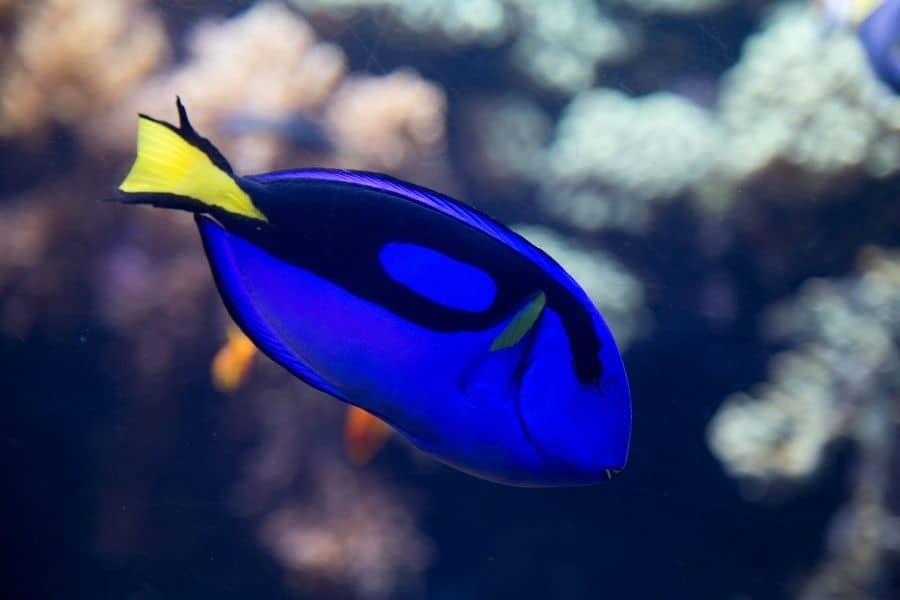
Blue tang has an electric blue color body with black color markings.
- Minimum tank requirement -180 gallons
- Length: 8 inches (21 cm)
- Minimum tank Size: 55 gallons
- Salinity requirement: 1.023-1.025 specific gravity
- Care level: Easy
- Temperament: Semi- Aggressive
- Natural Habitat: Indo-Pacific region
- Cost: $40
Brown Tang/Brown Surgeonfish (Acanthurus nigrofuscus)
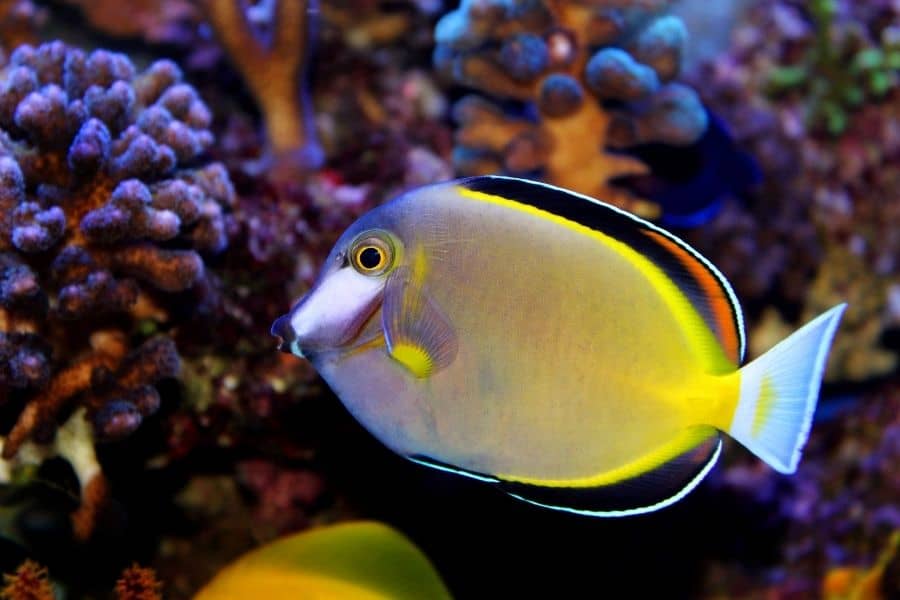
They are also known as lavender tang. They do not have vibrant body colors. But both their unique body color and pattern attract aquarist eyes. The brown color small spots spread around their head area.
- Minimum tank requirement -180 gallons
- Length: 12 inches (30 cm)
- Minimum tank Size: 120 gallons (454 l)
- Salinity requirement: 1.023-1.025 specific gravity
- Care level: Moderate
- Temperament: Aggressive
- In the Wild: Indo-Pacific region
- Cost: $60-$250
Clown Tang (Acanthurus lineatus)
Aquarists love their blue, and yellow strips that horizontally spread out the body.
Fowleri Tang (Acanthurus fowleri)
Flower tang is one of the largest members of the tang family. They have a yellow color body and blue color outlines on dorsal, pelvic, and caudal fins,
- Minimum tank requirement -180 gallons
- Length: 18 inches (45 cm)
- Minimum tank Size: 300 gallons (454 l)
- Salinity requirement: 1.023-1.025 specific gravity
- Care level: Moderate
- Temperament: Peaceful
- In the Wild: Indo- Indonesia
- Cost: $190-$250
Gem Tang (Zebrasoma gemmatum)
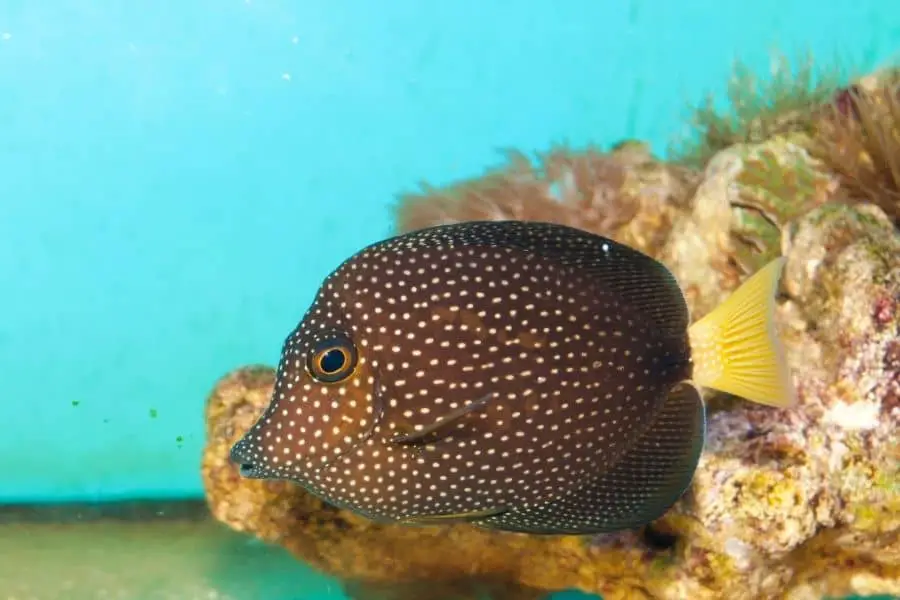
Gem tang is also known as spotted tang. It is the most expensive tang. Their white color spots spread on the whole body including the head area. Gem tang’s unique appearance attracts human’s eyes suddenly.
- Minimum tank requirement -180 gallons
- Length: 18 inches (45 cm)
- Minimum tank Size: 300 gallons (454 l)
- Salinity requirement: 1.023-1.025 specific gravity
- Care level: Moderate
- Temperament: Peaceful
- In the Wild: Indo- Indonesia
- Cost: $190-$250
Kole Tang (Ctenochaetus strigosus)
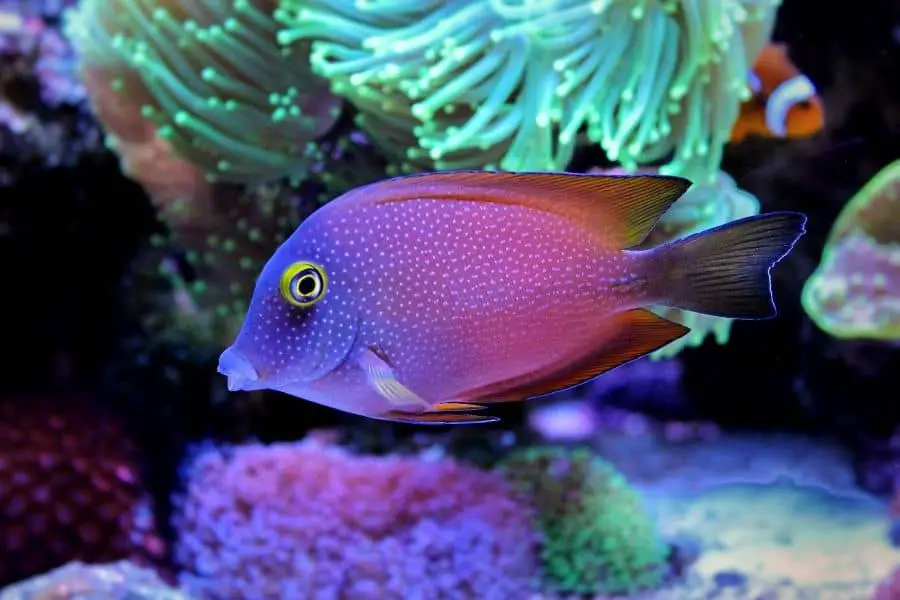
Kole or yellow-eyed tang has a stunning purple body and light purple color patches spread over the body. Their pelvic fins, eye, and mouth area are yellow. They are truly beautiful fish for reef water aquariums.
- Minimum tank requirement -180 gallons
- Length: 6 inches (15 cm)
- Minimum tank Size: 70 gallons
- Salinity requirement: 1.023-1.025 specific gravity
- Care level: East
- Temperament: Semi-Aggressive
- In the Wild: Indo- Indonesia
- Cost: $70-$110
Tank requirements
Size of the tank
You need a minimum of 180 gallons of the tank to rear them. Because they are highly sensitive fish and grow up to 14 inches in size. At least, you should have a 6 feet length tank minimally. Because they need a lot of open space to swim. You can keep a juvenile clown tang in a small tank. But you should have a large tank to rear them healthy and happy.
Water quality
Clown tangs need clean and well-oxygenated water. Further, your saltwater aquarium should meet the following water quality parameters to rear them safely.
Temperature
Water temperature should maintain 72 oF- 80oF (24oC – 28 oC). You can use an aquarium heater to maintain water temperature. An Aquarium thermometer can be installed in the aquarium to check the water temperature regularly.
The pH level of water
Water pH should be between 8.1-8.4.
Salinity
You should maintain salinity at the correct level to grow saltwater fish healthy. Because salinity level directly affects the “osmoregulation” of clown tang. The salinity level should be 1.023-1.025 (specific gravity). You can measure salinity using a hydrometer. In addition to that, you can prepare salinity water using treated potable water.
If that water contains any chlorine, use a de-chlorinator to remove it. Because chlorine can bleach corals of your aquarium and it is not good for fish too. Then add 35 grams of aquarium salt per one gallon of fresh water to create 35 ppt (1.023-1.025 specific gravity) saltwater media.
Flow rate
Clown tangs need well-oxygenated water and they love water currents. Thus you should use a powerhead or wavemaker to create that type of environment in your tank. In the natural environment, they inhabit a reef environment that is abundant with currents. Thus, they seek the same environmental parameters in captivity
Lighting
They do not need special light requirements. If they can find foods from current light conditions, it is enough for clownfish. But reef aquariums need lights to encourage photosynthesis in corals. Thus, you can use light for that purpose and enhance the beauty of your tank.
Acclimatization to tank
You should place fish with the polythene bag for up to 20 minutes in the tank water. Then fish can gradually adjust the temperature of the tank. After 20 minutes, release purchased clown tangs into the aquarium. Moreover, clown tang will not eat until they adjust to the new environment. You can put “Nori” under the rock of the aquarium. Eventually, the clown tang nips Nori and realized that is something they love to eat. Gradually they will adjust to the flake, pellet, and live foods too. You can do the same method to acclimate them to other food too.
How to breed clown tang
Most saltwater fish varieties are directly harvested from their natural habitat for the ornamental industry. Because their breeding procedures are a bit difficult in captivity. The Clown tang breeding process is stimulated by the moon cycle. In the wild, they spawn in the open waters just before or after the full moon appears. The clown tang’s eggs are moved with ocean currents until they hatch. After the egg hatch, fry clown tang fish swim to the bottom layer of the water. Thus, it is difficult to breed them in captivity. This is the reason that people collect them directly from their natural habitat.
Identify male female
It is difficult to determine male and female clown tang fish. If you take fish of the same age, female clown tangs are larger than male clown tags. Other than that females are more dominant than their male counterparts.
How fast do clown tang grow
The clownfish growth rate is 1 inch every 6 months until they reach up to 14 inches. Thus, they fully grow within 6 years. Some factors critically affect clown tang growth rate. Those are;
- Tank size
- Fish diet
- Water quality
- Tankmates
- Tank decor
If these factors are not in ideal conditions they will be stressed. That can slow up their growth.
What does clown tang eat?
Clown Tang is an omnivorous variety. Thus they can eat animal-plant matter and algae. Clown tangs spend their daytime nipping at the rocks grazing and sand beds. They highly prefer marine algae varieties. They are grazing on seaweeds, diatom debris, algae, and filamentous algae throughout the day. Marine algae strengthen their immune system and improve their overall health. Marine algae also help to reduce the stress of the clown tang fish that live in captivity. The following foods are ideal for clownfish that live in your aquarium and are very easy to use.
- Nori
- Lettuce clip
- Dried seaweed
- Veggie clip
- Sea Veggies
- Seaweed salad
- Frozen foods
- Ocean Nutrition product
Further, you can use Mysis shrimp and Brine shrimp to feed them. But a large portion of their diet should be greens. You can also provide broccoli, zucchini, spinach, spirulina, and other quality food to feed clownfish.
How to feed clown tang
Feeding frequency
In the wild, clownfish are always nipping algae and diatoms throughout the day. Thus, in captivity, they seek more food. Thus, feed them 3,4 times per day until they adjust to the tank conditions. After they acclimate to the new conditions, you can provide feed 2,3 times per day.
After feeding
Clown tangs are fast eaters. Because of that make sure that other organisms in the tank should have an adequate amount of food. After feeding clown tang, you can remove excess food from the tank.
Clown tangs tank mates
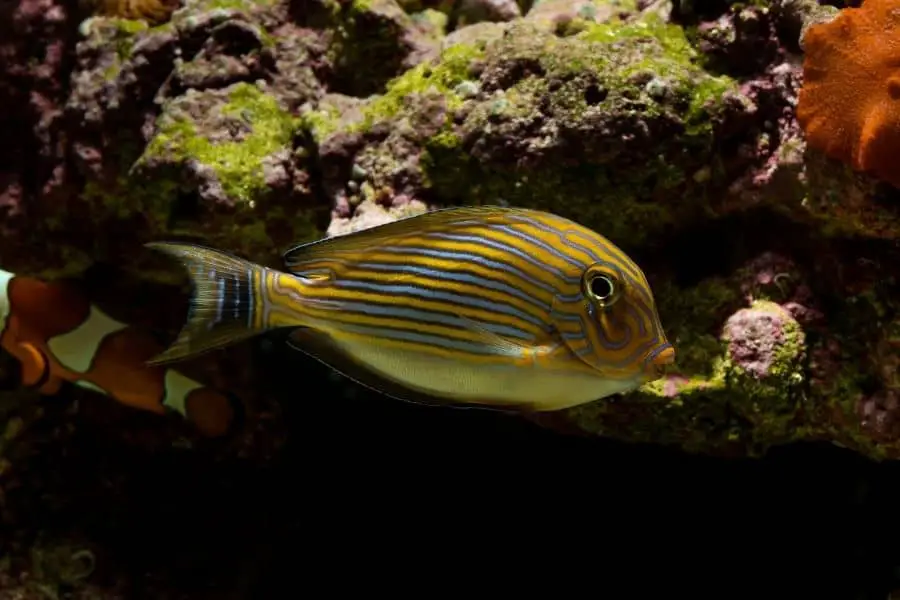
You should select tankmates carefully. A similar size saltwater fish should be fine. Further, you can keep clown tang with the other Tang fish varieties that have different color patterns and appearances. The suitable tang varieties are:
- Purple tang
- Tomini tang
- Yellow tang
- Scopas tang
- Sailfin tang
It is okay to add tangs that have dissimilar color patterns to clown tang. But you should carefully watch their behavioral changes. Because they will show some aggressive behavior when you add other Tangs with them. Because clown tangs worry about their territory. Do not add another clown to the same tank. It will enhance the aggressive level of clown tang.
Predators of clown tang
They have few ocean predators. Butterflyfish and humans are major predators of clownfish.
Why is clown tang dying?
Clown tang is dying because of several reasons in captivity. Those are;
- Poor water quality management
- low-quality feed
- Diseases
You should maintain correct salinity levels in your saltwater aquarium. Because saltwater organisms’ osmoregulation depends on it. If you do not control salinity at optimistic levels, they will die. Further, ammonia, nitrates, and nitrite amounts should be at zero. If it exceeds 10 ppm, it will be toxic to your tangs. These chemicals are generated because of the fecal matter of fish. Therefore, use a sufficient filter system to remove those materials from the tank. Diseases are another major reason that causes the death of clown tang.
Parasite disease on clownfish/ clownfish disease
Protozoan diseases are commonly found in marine fish varieties. The disease-causing parasite’s scientific name is Brooklynella hostilis. These parasites are commonly associated with the Amphiprioninae sub-family. Hence, this is commonly known as clownfish disease. This parasite attaches to the gills of the clown tang. The major symptom is difficulty of breathing. If you do not give treatment to fish immediately, fish will die.
If you notice the symptoms of this disease, remove those clown tangs from the main aquarium and place them into a quarantine tank. Copper, malachite green, and formalin 37% solution can be used to treat the infected fish. Further, black spot disease, Head and lateral line erosion disease, and Marine Ich are common diseases that can infect your clownfish. Therefore, quarantine for at least 2 weeks for your fish before adding them to the main aquarium.
How much they cost
The cost of clown tang differs with size.
- Small clown tang price – around $ 50
- Medium clown tang price – around $100
- Large clown tang price – around $ 160
Related topics
Are clown tangs dangerous?
Clown tangs have some sharp spines to protect them from predators. And also they are very active and fast swimmers. Therefore do not try to remove them using your hands. Because those spines are very sharp and it will hurt you. Use a cup to remove them from the tank. An aquarium net is not recommended. The sharp spines can attach to the net and fish will suck in it. It will damage your clown tang fish. If you handle them with proper care, they are not dangerous. Like other reef fish, clownfish are only used for ornamental purposes. Thus, do not try to consume it as a raw or processed meat product.
Is clown tang aggressive?
Clown tang is the most aggressive and energetic Tang fish. But they can live in community tanks with other reef fish varieties. They are a very friendly variety in community tanks until their territory is not threatened. As long as your aquarium is big enough, tang fish can live together with other varieties peacefully. They like to live with other Tangs that have different appearances. Generally, the same variety cannot live together.
Normally they swim quickly around the tank. That behavior can be a bit stressful to some aquarists. In the wild, there is one dominant male and a group of females swim together. That male clown tang guarding the female clown tangs.
Are clown tangs reef safe?
Yes, they are. Clownfish are reef safe and live peacefully with corals and invertebrates in their native habitat. Thus, like an aquarium hobbyist, you can add clown tang fish to your saltwater reef aquarium.
Can Clown tang with other tangs?
In the wild, dominant male clown tang fish live with a group of female clown tang fish. This dominant male fish protects the female fish. But in captivity, clowns tang highly worried about their space and territory. Thus, do not add the same variety of fish together. Further, clown tang can live in community tanks with other cousin tang varieties that have a different appearances. These tang varieties are Vlamingi tang, Tomini tang, Hippo tang, Orange shoulder tang, and yellow tang.
Read More : Blue Tang (Paracanthurus hepatus) Marine Fish Care Guide with pictures
